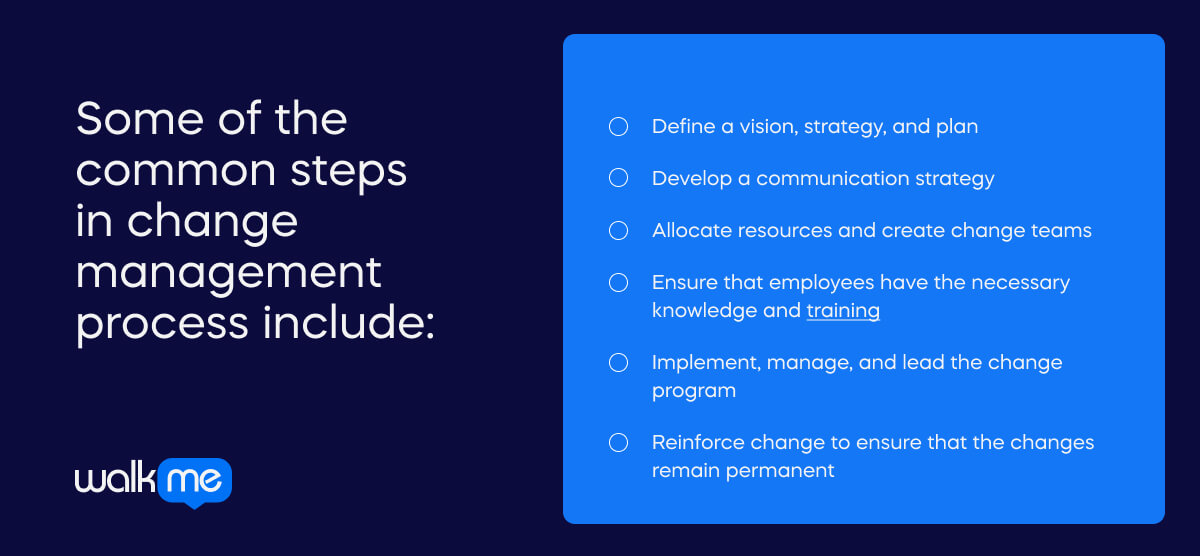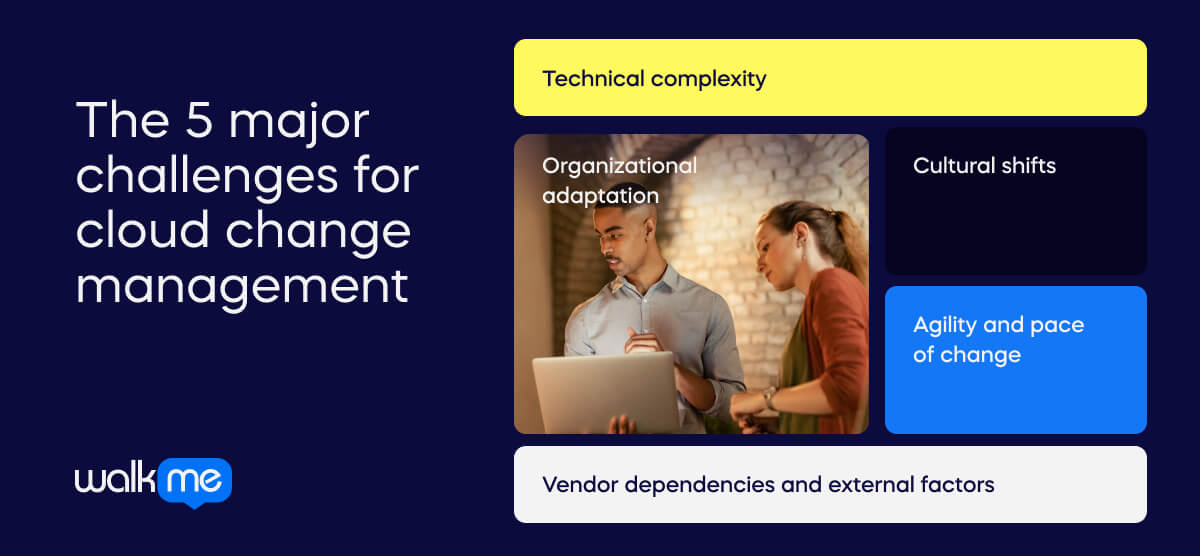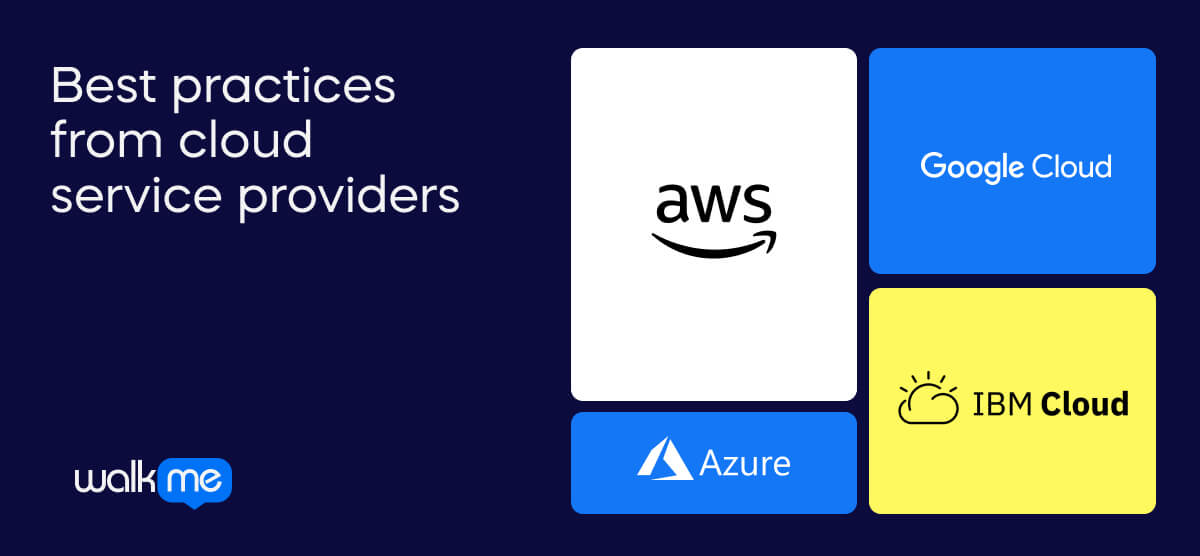What is Cloud Change Management?
Cloud change management refers to the policies, strategies, and people that help move a company’s digital assets from on-site to cloud-based computing systems. It focuses on minimizing risks, ensuring alignment with business objectives, and adapting traditional change management practices to the dynamic and scalable nature of cloud computing environments.

Table of contents
- What is Cloud Change Management?
- Cloud change management and traditional change management
- The five major challenges for cloud change management
- Cloud change management strategies for a successful digital transformation
- General best practices
- Principles of IT governance
- Best practices from cloud service providers
- ITIL change management vs. cloud change management
- The necessity of an effective cloud change management plan
Its significance has escalated due to the integral role that cloud technologies play in digital transformation initiatives. Cloud-based computing enables and catalyzes comprehensive digital change across organizations in a manner unprecedented in its scope.
Hence, proficient cloud transformation holds the potential to alleviate the challenges associated with on-site digital transformation, as acknowledged by a 2020 analysis by McKinsey.
However, implementing fully cloud-based systems presents significant challenges.
This emphasizes the importance of cloud change management. It extends the principles of change management to cover IT strategies, business processes, and corporate culture beyond technical aspects, ensuring a smooth and strategically aligned cloud transformation.
Cloud change management and traditional change management
If change were straightforward, the necessity for change management would be obviated. Regrettably, the introduction of novel work methodologies mandates a structured change management process to ensure proper implementation of the solution.
Traditional change management methodologies, applied to scenarios such as mergers, restructuring, and redundancies, impart valuable insights into optimal approaches for digital transformation and cloud change management.
Some of the common steps in change management process include:
- Define a vision, strategy, and plan
- Develop a communication strategy
- Allocate resources and create change teams
- Ensure that employees have the necessary knowledge and training
- Implement, manage, and lead the change program
- Reinforce change to ensure that the changes remain permanent
Cloud change management necessitates several key steps. Elements such as vision, communication, resource allocation, training, and implementation play crucial roles in the success of cloud migration projects.
However, it’s essential to recognize that cloud projects present distinct challenges not encountered in more conventional change processes.

The five major challenges for cloud change management

When it comes to digital transformation, there are unique considerations in technical, organizational, and cultural realms that are distinct even compared to change management in IT.
- Technical complexity
Cloud change management grapples with intricate technical challenges arising from the dynamic nature and diverse architectures of cloud environments. Unlike traditional IT, the distributed nature of cloud services complicates predicting and managing change impacts, adding complexity to configuration and dependency control.
- Organizational adaptation
Aligning existing organizational structures with cloud change management poses a substantial challenge. Translating traditional IT change management to the cloud proves complex, requiring navigation of role changes, skill gaps, and the redefinition of responsibilities. Resistance to change and cultural shifts hinder effective cloud-related change implementation.
- Cultural shifts
Introducing cloud change management necessitates a cultural shift towards collaboration, innovation, and agility. Overcoming resistance, addressing job displacement fears, and breaking away from established practices are obstacles to the cultural transformation vital for successful cloud adoption.
- Agility and pace of change
Cloud environments’ inherent agility challenges traditional change management designed for a slower release cycle—the rapid deployment and updates in the cloud demand continuous adaptation. Striking a balance between agility and the need for control becomes a critical challenge in cloud change management.
- Vendor dependencies and external factors
External dependencies on cloud service providers add complexity beyond an organization’s control. Managing changes amidst third-party release schedules, potential service disruptions, and adherence to their change management practices requires negotiation and alignment with internal processes.
Cloud change management strategies for a successful digital transformation
To meet these challenges, organizations can rely on several established practices to support risk management, facilitate the deployment process, and continuously monitor the impact of the change.
This section will explore general best practices, lessons from IT governance authorities, and cloud resources from major cloud infrastructure providers.
General best practices
In any comprehensive introduction to cloud change management, you’ll find a thorough account of tactics planning, implementation, and ongoing review.
As such, the best change leaders will make sure that they cover the following areas when they are getting ready for a cloud implementation:
- Establish clear business objectives for the cloud transformation project
- Conduct a comprehensive assessment of existing systems, applications, and data to determine migration suitability
- Prioritize migration of workloads based on business criticality
- Ensure data security and compliance
- Assemble a skilled and cross-functional migration team
- Conduct pilot migrations to validate the migration plan and identify issues
- Implement strong backup and disaster recovery processes
- Monitor and manage costs by optimizing resources
- Document and support the migration process
- Maintain documentation and have a plan for post-migration support
These steps provide a solid start. For further insights, delve into the principles of IT governance and adhere to best practices recommended by cloud service providers.
Principles of IT governance
Certain elements commonly appear in a cloud transition. To delve deeper, explore the following approaches:
- The ITIL (Information Technology Infrastructure Library) framework is a comprehensive set of best practices for IT service management. If cloud change management, ITIL covers a broad spectrum of considerations, offering guidance on service strategy, design, transition, and operation. Leveraging ITIL principles enhances the structured approach to change management in the dynamic cloud environment.
- The International Organization for Standardization (ISO) has developed a standard tailored to cloud infrastructure management. The standard at ISO 66296 outlines principles and practices for managing cloud services. Adhering to these standards provides organizations a framework to ensure security, interoperability, and effective governance in their cloud initiatives.
- From a business perspective, Gartner is a prominent authority offering valuable insights on cloud strategy. Their comprehensive Gartner Cloud Strategy delves into key considerations for organizations navigating the complexities of cloud adoption. Gartner’s research aids in informed decision-making, helping organizations align their cloud strategies with business goals.
Best practices from cloud service providers

Some of the most valuable sources of expertise about cloud transitions come from cloud providers themselves.
Service providers make substantial investments in documentation for their respective services. This commitment is sustained through ongoing investments in content and guidance addressing the latest issues in cloud implementation.
For example:
- AWS provides a comprehensive Cloud Adoption Framework as a foundational guide for organizations transitioning to the cloud. This framework offers practical insights and best practices, covering key aspects of strategy, business, and technology.
- Microsoft’s Azure Cloud Adoption Framework is a robust resource designed to assist organizations in their cloud journey. It encompasses a structured approach to cloud adoption, guiding strategy, planning, and implementation specific to the Azure platform.
- GCP’s Adoption Framework offers valuable papers on cloud change management. Google provides in-depth insights into adopting and optimizing cloud services, ensuring organizations can make informed decisions for successful transitions.
- IBM’s Cloud adoption and transformation field guide serves as a comprehensive field guide for cloud adoption and transformation. It covers various topics, providing practical guidance and best practices for organizations considering or undergoing cloud adoption using IBM Cloud services.
ITIL change management vs. cloud change management
Older ITSM systems are not naturally capable of delivering business value from the novel challenges of the cloud environment. However, older forms of IT change management, such as ITIL change management, have adapted to the challenges of cloud computing.
Previously, experts did not believe this was achievable. In a 2011 conversation, Rick LiaBraaten asserted, “I can sum up [ITIL] Change Management in The Cloud in two words: You Can’t.” However, a 2021 AWS white paper contradicts this view, affirming that ITIL is fully compatible with the AWS Cloud Adoption Framework.
Axelos offers a specialist module in cloud services in ITIL, which tackles a wide range of key issues in cloud change management. This requires candidates to define an organization’s requirements for cloud adoption, identify cloud services and their applicability, select and procure cloud services, and migrate to or from the cloud.
![I can sum up [ITIL] Change Management in The Cloud in two words: You Can’t.](https://www.walkme.com/wp-content/uploads/2024/02/In-a-2011-conversation-Rick-LiaBraaten-asserted_265cddf9.jpg)
The necessity of an effective cloud change management plan
Propelling organizations into the digital forefront, cloud change management is the linchpin for a triumphant transformation.
This dynamic approach seamlessly synchronizes technology, strategic endeavors, and the human factor, setting the stage for businesses to overcome cloud challenges and ride the wave of its full potential on a transformative odyssey.
Embracing this forward-thinking methodology isn’t just a trend; it’s a commitment to unlocking the genuine power of the cloud. Businesses adopting this strategic approach invest in a future marked by unprecedented innovation, elevated operational efficiency, and enduring success.
As cloud change management becomes a staple, savvy businesses are not merely adapting but actively shaping their digital identity.